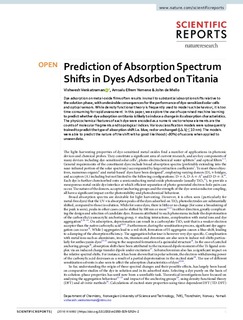| dc.contributor.author | Venkatraman, Vishwesh | |
| dc.contributor.author | Yemene, Amsalu Efrem | |
| dc.contributor.author | De Mello, John Christian | |
| dc.date.accessioned | 2020-02-07T07:43:41Z | |
| dc.date.available | 2020-02-07T07:43:41Z | |
| dc.date.created | 2020-01-09T10:44:28Z | |
| dc.date.issued | 2019 | |
| dc.identifier.citation | Scientific Reports. 2019, 9 (1), . | nb_NO |
| dc.identifier.issn | 2045-2322 | |
| dc.identifier.uri | http://hdl.handle.net/11250/2640136 | |
| dc.description.abstract | Dye adsorption on metal-oxide films often results in small to substantial absorption shifts relative to the solution phase, with undesirable consequences for the performance of dye-sensitized solar cells and optical sensors. While density functional theory is frequently used to model such behaviour, it is too time-consuming for rapid assessment. In this paper, we explore the use of supervised machine learning to predict whether dye adsorption on titania is likely to induce a change in its absorption characteristics. The physicochemical features of each dye were encoded as a numeric vector whose elements are the counts of molecular fragments and topological indices. Various classification models were subsequently trained to predict the type of absorption shift i.e. blue, red or unchanged (|Δλ| ≤ 10 nm). The models were able to predict the nature of the shift with a good likelihood (~80%) of success when applied to unseen data. | nb_NO |
| dc.language.iso | eng | nb_NO |
| dc.publisher | Springer Nature | nb_NO |
| dc.rights | Navngivelse 4.0 Internasjonal | * |
| dc.rights.uri | http://creativecommons.org/licenses/by/4.0/deed.no | * |
| dc.title | Prediction of Absorption Spectrum Shifts in Dyes Adsorbed on Titania | nb_NO |
| dc.type | Journal article | nb_NO |
| dc.type | Peer reviewed | nb_NO |
| dc.description.version | publishedVersion | nb_NO |
| dc.source.pagenumber | 13 | nb_NO |
| dc.source.volume | 9 | nb_NO |
| dc.source.journal | Scientific Reports | nb_NO |
| dc.source.issue | 1 | nb_NO |
| dc.identifier.doi | 10.1038/s41598-019-53534-2 | |
| dc.identifier.cristin | 1769091 | |
| dc.description.localcode | Open Access This article is licensed under a Creative Commons Attribution 4.0 International License, which permits use, sharing, adaptation, distribution and reproduction in any medium or format, as long as you give appropriate credit to the original author(s) and the source, provide a link to the Creative Commons license, and indicate if changes were made. The images or other third party material in this article are included in the article’s Creative Commons license, unless indicated otherwise in a credit line to the material. If material is not included in the article’s Creative Commons license and your intended use is not permitted by statutory regulation or exceeds the permitted use, you will need to obtain permission directly from the copyright holder. To view a copy of this license, visit http://creativecommons.org/licenses/by/4.0/. | nb_NO |
| cristin.unitcode | 194,66,25,0 | |
| cristin.unitname | Institutt for kjemi | |
| cristin.ispublished | true | |
| cristin.fulltext | original | |
| cristin.qualitycode | 1 | |

